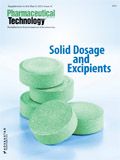Physical-Chemical Identifiers: A Q&A with FDA on the Final Guidance
FDA answers key questions about the October 2011 guidance on using physical–chemical identifiers in solid oral dosage products to help prevent and avoid counterfeiting.
Background
FDA published in October 2011 the final guidance, Incorporation of Physical- Chemical Identifiers (PCIDs) into Solid Oral Dosage Form Drug Products for Anticounterfeiting (1). The document was issued as a follow-up to the agency's 2004 Counterfeit Drug Task Force Report to facilitate the use of authentication technologies such as PCIDs, and is meant to provide guidance for industry on how using the technology would change the information expected to be provided in regulatory submission (2). The use of a PCID, defined in the guidance as "a substance or combination of substances possessing a unique physical or chemical property that unequivocally identifies and authenticates a drug product or dosage form," is voluntary. PCIDs include inks, pigments, flavors, and molecular taggants.
In the guidance, FDA recommends that the PCID's ingredients be pharmacologically inactive so that they can be treated as excipients. To minimize toxicological risk, the agency recommends that drugmakers use permissible direct food additives, food substances that are generally recognized as safe (GRAS), or ingredients listed in the agency's Inactive Ingredient Guide (IIG) that have been used in solid oral dosage forms.
To minimize the risk that a PCID will adversely affect the dosage form's identity, strength, quality, purity, potency, or bioavailability, FDA recommends that companies add a PCID to the product at the lowest level that will ensure the dosage unit's identification. PCIDs that are relatively inert also can minimize the potential for adverse interactions. In addition, the guidance states that manufacturers should examine the potential effect of a PCID on the product's quality, performance, and stability.
In terms of documentation, the guidance includes recommendations for new drug and abbreviated new drug applicants proposing to incorporate PCIDs into new solid oral dosage forms. The guidance also describes the documentation recommended for applicants that want to incorporate PCIDs into solid oral dosage forms as a postapproval change.
The amount of information to be provided for a PCID depends on its pharmacological characteristics, toxicological characteristics, and design, according to the guidance. Less information would be expected for a PCID that is a permissible direct food additive, a food substance that is GRAS, or an ingredient listed in the IIG than for a novel PCID. According to the guidance, the agency would expect to see information about items such as the PCID's chemical composition, the rationale for selecting the PCID, how the PCID is integrated into the product, the location of the PCID in the product, and the relevant physical–chemical attributes of the PCID.
Pharmaceutical Technology asked the agency a few follow-up questions about the guidance and plans going forward. The responses are provided by an FDA Spokesperson.
PharmTech: Location and presence of a PCID in a solid dosage form is crucial in order to avoid interaction with the drug substance. What are the key concerns that manufacturers must consider in this regard (e.g., release rate, drug substance interaction)?
FDA: The key concerns for the presence and location of a PCID in a solid oral dosage form are potential interactions with the drug substance and potential impact on the drug product release rate. Interactions with the drug substance could cause degradation. Interactions with rate-controlling exipients could impact the release rate of extended release or delayed release dosage forms.
PharmTech: It is recommended that industry use already approved direct food additives (e.g., those listed in GRAS or IIG) at the lowest specified levels to avoid adverse reactions. Does the agency have plans to create a list of specific PCIDs for the pharmaceutical industry to be used in the future? Will PCIDs that are not in the GRAS or IIG be considered by the agency if submitted by an applicant for use?
FDA: The agency does not have plans to create a list of specific PCIDs for the pharmaceutical industry. Proposals for the use of PCIDs that are not in the GRAS or IIG lists can be submitted by an applicant for evaluation by FDA.
PharmTech: According to the guidance, "There are various available means for presentation and detection of PCIDs (e.g., photolithography, holography, optical microscopy, laser scanning devices, excitation/fluorescence detection). Some identifying characteristics, such as pigments or flavors, could be easily observed by patients, healthcare practitioners, and pharmacists. Others could require the use of a detection instrument (e.g., a scanner, photometric detector, mass spectrometry)." What is the expectation in terms of who has responsibility—for example, healthcare providers or pharmacists—for determining and authenticating the presence of a PCID before patient distribution?
FDA: There is no intention by FDA to place a burden of responsibility on healthcare providers to authenticate drugs by determining the presence of a PCID before patient distribution.
PharmTech: Are there plans to extend the guidance beyond solid dosage forms?
FDA: There are no plans at this time to extend the guidance on PCIDs beyond solid oral dosage forms.
PharmTech: What other anticounterfeiting measures does FDA recommend for oral solid dosage forms in addition to PCIDs?
FDA: FDA encourages manufacturers to continue exploring promising technologies for use as anticounterfeiting measures. These may include radiofrequency identification (RFID), nanotechnology, encryption and other track-and-trace technologies.
PharmTech: Manufacturers can submit information about their intent to use a PCID in a solid oral dosage product in an NDA or ANDA or as a postappoval change. Some industry members have raised convern over confidentiality. Can you confirm that PCID information submitted in these documents is confidential and therefore protected from would-be counterfeiters?
FDA: FDA confirms that information on PCIDs submitted by applicants or master file holders is considered confidential.
Reference
1. FDA, Guidance for Industry: Incorporation of Physical- Chemical Identifiers (PCIDs) into Solid Oral Dosage Form Drug Products for Anticounterfeiting (Rockville, MD, October 2011).
2. FDA, Counterfeit Drug Task Force Report: "Combating Counterfeit Drugs" (Rockville, MD, February 2004).
